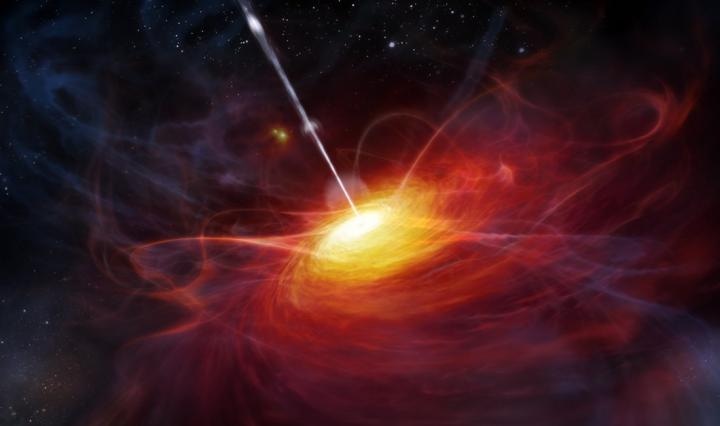Sep 12 2016
 This is an artist's rendering of a very distant quasar courtesy of ESO/M. Kornmesser. Credit: ESO/M. Kornmesser.
This is an artist's rendering of a very distant quasar courtesy of ESO/M. Kornmesser. Credit: ESO/M. Kornmesser.
Quasars are supermassive black holes situated at the center of huge galaxies, accreting matter. They are often called beacons as they shine so bright, and Quasars are among the most-distant objects present in the universe that can be considered for current research.
A team headed by Carnegie's Eduardo Bañados recently discovered 63 new quasars from when the universe was only a billion years old. (Today it is about 14 billion years old).
This discovery is the largest sample of such distant quasars presented in a single scientific article, almost doubling the number of ancient quasars known previously. The results will be featured in The Astrophysical Journal Supplement Series.
Quasars are among the brightest objects and they literally illuminate our knowledge of the early universe.
Eduardo Bañado, Carnegie Institute for Science
Until now there was only a small percentage of ancient quasars that were known to exist and this limits the ability of scientists to gather information. The key challenge is to find these distant quasars, which are extremely rare. Scentists have tried for decades to find the quasars but the challenge is comparable to finding a needle in a haystack.
The quasars identified by Bañados and team will offer significant information from the first billion years after the Big Bang, which refers to a period of immense interest to astronomers.
Why?
The Big Bang created the universe and hot matter exploded everywhere. The universe later cooled off enough for the first electrons and protons to develop and then integrate into hydrogen atoms, resulting in a dark universe for a prolonged time period.
The formation of larger structures by the atomic nuclei enabled light to shine once again in the universe. This took place when gravity condensed the matter and created the first sources of illumination, which could have contained quasars.
There are still details about this era when the lights of the universe were turned back on that science do not understand. However, experts will be able to discover what happened in the first billion years after the Big Bang with the help of additional examples of ancient quasars.
The formation and evolution of the earliest light sources and structures in the universe is one of the greatest mysteries in astronomy. Very bright quasars such as the 63 discovered in this study are the best tools for helping us probe the early universe. But until now, conclusive results have been limited by the very small sample size of ancient quasars.
Eduardo Bañado, Carnegie Institute for Science
These discoveries will help enhance the present understanding about the early universe.
This research received financially aid from a NASA Hubble Fellowship, the National Science Foundation, the European Research Council, and a Carnegie-Princeton Fellowship.
This research includes data generated from the following facilities: PS1 (GPC1), VLT:Antu (FORS2), NTT (EFOSC2), LBT (MODS), Max Planck:2.2m (GROND), Magellan:Baade (FIRE), Magellan:Clay (LDSS3), Keck:I (LRIS), Hale (DBSP), CAO:3.5m (Omega2000), CAO:2.2m (CAFOS), MMT (SWIRC), Du Pont (Retrocam).